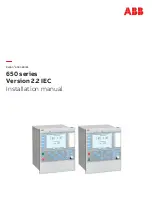
Powered by Safety
®
25
Installation
IB-60201
Powell recognizes the widespread use
of DC hipot equipment in the field and
the desire to use this equipment to verify
vacuum integrity. However, the capacitive
component of the vacuum interrupter
during DC testing may yield false negative
test results, which are often misinterpreted
as vacuum interrupter failure. When DC
testing is performed, a test set providing
a full wave rectified 50kVDC hipot voltage
can be applied for 5 seconds as a
“go - no go” test.
Recording the leakage readings is not
necessary, as a dielectric breakdown will
trip all portable DC hipot test sets. If a
DC test breakdown occurs, the test must
be repeated after reversing the DC high
voltage test supply connection across the
vacuum interrupter. A vacuum interrupter
should be questioned only if it has failed
both tests.
When testing with DC, use a DC high potential
test (hipot) set with full wave rectification.
Many DC high potential test sets use half-
wave rectification. Do not use these half-wave
rectifiers. The capacitance of the vacuum
interrupter in combination with the leakage
currents in the rectifiers and its DC voltage
measuring equipment may result in applying
peak voltages as much as three times the
measured voltage. These abnormally high
voltages may give a false indication of a
defective vacuum interrupter, and may
produce abnormal x-radiation.
CAUTION
CAUTION
!
If DC high potential testing (hipot) is required,
the DC high potential test machine must
not produce instantaneous peak voltages
exceeding 50kV.
CAUTION
CAUTION
!
No attempt should be made to try to
compare the condition of one vacuum
interrupter with another, nor to correlate
the condition of any vacuum interrupter
with low values of DC leakage current.
There is no significant correlation.
After the high potential is removed, an
electrical charge may be retained by the
vacuum interrupters. Failure to discharge this
residual electrostatic charge could result in an
electrical shock. All six primary disconnecting
devices of the circuit breaker and the metallic
mid band ring if present should be grounded
and remain grounded for at least one minute to
reduce this electrical charge before coming in
to contact with the primary circuit.
CAUTION
CAUTION
!
3) Control Voltage Insulation Integrity
If the user wishes to check the insulation
integrity of the control circuit, it may be
done with a 500V or 1000V insulation
resistance tester or with an AC high
potential tester. The AC high potential test
should be made at 1125V, 50 or 60 Hz for
one minute. The charging motor must be
disconnected prior to testing the control
circuit. The charging motor itself may be
similarly tested at a voltage not to exceed
675V, 50 or 60 Hz. Be sure to remove any
test jumpers and reconnect the charging
motor when the tests are complete.
Remove all grounding conductors applied
for this test before placing the circuit breaker
back into service.
CAUTION
CAUTION
!
















































